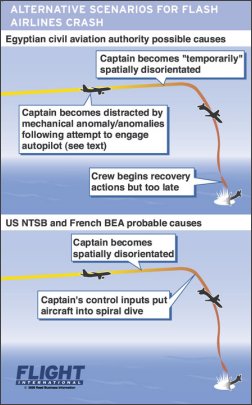Egyptians highlight variety of possible technical failings, but France and USA say pilot disorientation was cause
For the second time in four years Egyptian and US air accident investigators have disagreed about the cause of an accident (see related news and graphics below).
|
In the report on the 3 January 2004 Flash Airlines Boeing 737-300 crash, Egypt’s air accident investigator has ruled that the cause of the aircraft’s dive into the Red Sea near Sharm el Sheikh is uncertain, but has ventured a number of scenarios that might explain it.
The Egyptian civil aviation authority investigation team, led by Capt Shaker Kelada, reported: “No conclusive evidence could be found from the findings gathered through this investigation to determine a probable cause...[but] any combination of these findings could have caused or contributed to the accident. Although the crew at the last stage of the accident attempted to correctly recover, the gravity of the upset condition with regard to attitude, altitude and speed made this attempt insufficient to achieve a successful recovery.”
Kelada listed the findings as “possible causes”. They include “trim/feel unit fault (aileron trim runaway); temporarily, spoiler wing cable jam (spoiler offset of the neutral position); temporarily, first officer [control] wheel jam (spoilers offset of the neutral position); autopilots actuator hardover fault.”
Both the US National Transportation Safety Board (NTSB) and the French investigation board BEA, in comments appended to the report, say there is no evidence of technical failure that could have led to the upset. They maintain that the cockpit voice recorder (CVR) transcript and the flight profile indicate that the captain – the pilot flying – had become spatially disorientated during the night departure.
The aircraft was in a left climbing turn out of Sharm el Sheikh over the sea at night when the aircraft began to diverge from the crew’s planned path. The captain’s control inputs, the two agencies say, put the aircraft into a right-hand spiral dive and the co-pilot recognised this too late to recover the aircraft. It hit the sea, killing all 13 crew and 135 passengers.
In a fax to Kelada, the head of the Egyptian CAA concurs with the investigation’s final draft verdict that “the captain was temporarily distracted and may have developed temporary spatial disorientation [that] was a reaction to some previous happening.”
For that reason, the Egyptian CAA says, the final report should refer to the captain’s spatial disorientation as only a contributory factor, not as a cause.
The NTSB, in a letter to the Egyptian CAA, maintains there is “no evidence that an airplane-related malfunction or failure caused or contributed to the accident”. The NTSB’s comments in the report say the CVR and flight data recorder readings show the captain “experienced spatial disorientation [and] the first officer did not assume timely control of the aircraft”.
The Egyptian investigators conclude that the control inputs were consistent with the behaviour of the aircraft. The NTSB agrees with this and adds: “The aileron inputs and corresponding right roll... resulted from inadvertent flightcrew inputs.” The BEA concedes that “two hypotheses were not eliminated” – the aileron trim runaway and autopilot actuator hardover – but insists even if these had occurred “the crew would still have been able to control the airplane’s track”. Boeing says it agrees with the BEA and NTSB.
The airline says: “Flash does not accept the existence of any spatial disorientation on the part of the flightcrew, or that it is acceptable for the report to make any finding to that effect in the absence of unequivocal and positive indicators of its presence.”
DAVID LEARMOUNT / LONDON
Source: Flight International
























